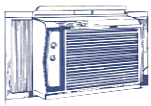| Vol. 2, No.
6 |
From the desk of ...
Arthur S. Lazerow |
ALBAN
Home Inspection Service
To: All Listing Agents
(Part I of 3) |
After 1200 home inspections, I have seen many
homes in deplorable condition. I wonder why sellers do not heed their listing Realtor's
admonition to perform maintenance or routine replacements to maximize selling price,
minimize sale time, and facilitate a successful home inspection.
It is no surprise that buyers find comfort from their home inspector's positive
observations, such as "newly installed", "signs of maintenance", or
"timely replacement." Conversely, signs of deferred or improper maintenance have
caused several contracts for which we inspected to be terminated. One was a magnificent
country home with very few serious deficiencies but with so many obvious maintenance
defects that the purchaser not only canceled the sale but questioned the seller's sanity.
Listing agents should redouble their efforts to bring every listing into the best possible
condition. Next month's newsletter will discuss exterior improvements to enhance a
property and the following month will focus on interior conditions.
|

|
573 Lancaster Place
Frederick, Maryland 21702
Metro 1-800-822-7200
301-662-6565 |
Full Fee Refund
IF SALE DOESN'T CLOSE |
|
How
To Choose The
Right Air Conditioner
A larger air conditioner is not necessarily better,
because a unit that is too large will not uniformly cool an area, Moreover, it may not
provide adequate dehumidification, which is very important in providing comfort, since
lower humidity reduces skin temperature and makes warmer temperatures feel cooler.
A unit that's too large is less efficient at dehumidification because it will cycle on and
off too frequently and its settings will have to be three or four degrees cooler to make
up for the higher humidity. It is also more expensive to operate, so it's better to
slightly undersize a unit than oversize it. This is more critical with central systems
than with window units.
To size an air conditioner, consider the dimensions of the area to be cooled and how the
area is used. Based on size alone, an air conditioner generally needs 20 British thermal
units (BTUs) for each square foot of living space. For example, an air conditioner with a
6,000-BTU capacity is required to cool a room that is 15 feet wide and 20 feet long: 15
(width) x 20 (length) x 20 (BTUs) = 6,000. This is a very simplified calculation method
since it does not take into account other important factors such as the room's height,
local climate, and insulation.
 Calculating
BTU requirements becomes more complicated when considering the area's use. For instance,
passive cooling techniques such as shading, ventilation, and vegetation lower the BTU
estimate. BTU requirements are also affected by factors such as the size of the household,
usage patterns of beat producing appliances, and summertime humidity levels. Appliance
dealers will adjust the estimated BTU requirement based on these factors. For the most
efficient cooling, purchase a unit with a capacity within 5% of this estimate. Calculating
BTU requirements becomes more complicated when considering the area's use. For instance,
passive cooling techniques such as shading, ventilation, and vegetation lower the BTU
estimate. BTU requirements are also affected by factors such as the size of the household,
usage patterns of beat producing appliances, and summertime humidity levels. Appliance
dealers will adjust the estimated BTU requirement based on these factors. For the most
efficient cooling, purchase a unit with a capacity within 5% of this estimate.
|
|
| Know
The Location of System Shut-offs ... |
Here is a list of systems in the home that should be
located and marked with a tag in case of an emergency. Taking time to locate and tag these
components now could save headaches and a lot of money later.
1) Main water shut off for the water system.
2) Water shut offs for each plumbing fixture.
3) Clean outs in the sanitary waste lines. 
4) Electrical distribution panel ledger should list the location of
all circuits.
5) Shut off valve for the gas main.
6) Shut offs and pilot lights on each gas appliance.
7) Valves from the oil tank
8) Septic tank lid, distribution box, and leaching field.
9) Main electrical disconnect, if separate. |
|
| || Next
Page || Back to Index Page || Alban Home || |
|